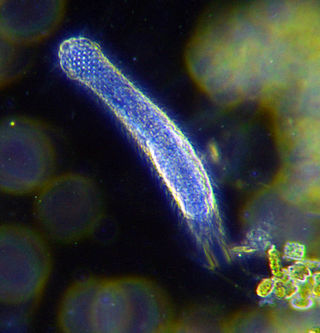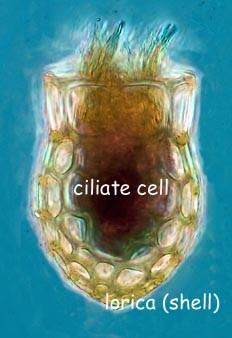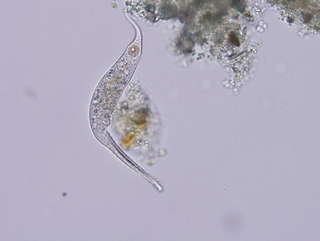
The spirotrichs are a large and diverse group of ciliate protozoa. They typically have prominent oral cilia in the form of a series of polykinetids, called the adoral zone of membranelles, beginning anterior to the oral cavity and running down to the left side of the mouth. There may also be one or two paroral membranes on its right side. The body cilia are fused to form polykinetids called cirri in some, and are sparse to absent in others.

The gastrotrichs, commonly referred to as hairybellies or hairybacks, are a group of microscopic (0.06–3.0 mm), cylindrical, acoelomate animals, and are widely distributed and abundant in freshwater and marine environments. They are mostly benthic and live within the periphyton, the layer of tiny organisms and detritus that is found on the seabed and the beds of other water bodies. The majority live on and between particles of sediment or on other submerged surfaces, but a few species are terrestrial and live on land in the film of water surrounding grains of soil. Gastrotrichs are divided into two orders, the Macrodasyida which are marine, and the Chaetonotida, some of which are marine and some freshwater. Nearly 800 species of gastrotrich have been described.

The Oligohymenophorea are a large class of ciliates. There is typically a ventral groove containing the mouth and distinct oral cilia, separate from those of the body. These include a paroral membrane to the right of the mouth and membranelles, usually three in number, to its left. The cytopharynx is inconspicuous and never forms the complex cyrtos found in similar classes. Body cilia generally arise from monokinetids, with dikinetids occurring in limited distribution over part of the body.

The peritrichs are a large and distinctive group of ciliates.

Paramecium is a genus of eukaryotic, unicellular ciliates, commonly studied as a model organism of the ciliate group. Paramecium are widespread in freshwater, brackish, and marine environments and are often abundant in stagnant basins and ponds. Because some species are readily cultivated and easily induced to conjugate and divide, they have been widely used in classrooms and laboratories to study biological processes. The usefulness of Paramecium as a model organism has caused one ciliate researcher to characterize it as the "white rat" of the phylum Ciliophora.

The Colpodea are a class of ciliates, of about 200 species common in freshwater and soil habitats. The body cilia are typically uniform, and are supported by dikinetids of characteristic structure, with cilia on both kinetosomes. The mouth may be apical or ventral, with more or less prominent associated polykinetids. Many are asymmetrical, the cells twisting sideways and then untwisting again prior to division, which often takes place within cysts. Colpoda, a kidney-shaped ciliate common in organic rich conditions, is representative.

Stylonychia is a genus of ciliates, in the subclass Hypotrichia. Species of Stylonychia are very common in fresh water and soil, and may be found on filamentous algae, surface films, and among particles of sediment. Like other Hypotrichs, Stylonychia has cilia grouped into membranelles alongside the mouth and cirri over the body. It is distinguished partly by long cirri at the posterior, usually a cluster of three. The largest can just be seen at a 25x magnification, and the smallest can just be seen at a 450x magnification.

Tintinnids are ciliates of the choreotrich order Tintinnida, distinguished by vase-shaped shells, the name deriving from a Latin source meaning a small tinkling bell, that are called loricae, which are mostly protein but may incorporate minute pieces of minerals.

Theodoxus fluviatilis, common name the river nerite, is a species of small freshwater and brackish water snail with a gill and an operculum, an aquatic gastropod mollusk in the family Neritidae, the nerites.

Geoplanidae is a family of flatworms known commonly as land planarians or land flatworms.

Coleps is a genus of ciliates in the class Prostomatea with barrel-shaped bodies surrounded by regularly arranged plates composed of calcium carbonate.
''''' is a of karyorelictean ciliates, belonging to Loxodidae. It is the only known karyorelictean ciliate that lives in freshwater habitats.

Euplotes is a genus of ciliates in the subclass Euplotia. Species are widely distributed in marine and freshwater environments, as well as soil and moss. Most members of the genus are free-living, but two species have been recorded as commensal organisms in the digestive tracts of sea urchins.
Polynucleobacter is a genus of bacteria, originally established by Heckmann and Schmidt (1987) to exclusively harbor obligate endosymbionts of ciliates belonging to the genus Euplotes.
Hyalophysa chattoni is an apostome ciliate of the order Apostomatida. The polymorphic symbiont is carried as an encysted phoront on the exoskeleton of few arthropods belonging to the subphylum Crustacea and undergoes metamorphosis during the host's premolt followed by various other life-cycle stages.

Colliniidae is a family of ciliates of the order Apostomatida.

The Foettingeriidae are a family of apostome ciliates of the order Apostomatida. Like other apostomes, they are symbiotic with Crustacea, and live in microbial cysts on their host's exoskeleton for most of their life. They excyst, or leave their cysts, when their hosts molt their exoskeleton in order to feed on the exuvial fluids trapped in their host's molted exoskeleton.

Dileptus margaritifer is a species of ciliates in the family Dileptidae. It is common in freshwater streams, lakes and ponds, as well as mosses and soil. The species has been found on every continent except Antarctica.

Chromidina is a genus of apostome ciliates of the family Opalinopsidae. Species of Chromidina are parasitic in the renal and pancreatic appendages of cephalopods.
Scuticociliatia is a subclass of ciliates in the class Oligohymenophorea. Its members are called scuticociliates. These unicellular eukaryotes are microorganisms that are usually free-living and can be found in freshwater, marine, and soil habitats. Around 20 members of the group have been identified as causative agents of the disease scuticociliatosis, in which the ciliates are parasites of other marine organisms. Species known to be susceptible include a broad range of teleosts, seahorses, sharks, and some crustaceans.














